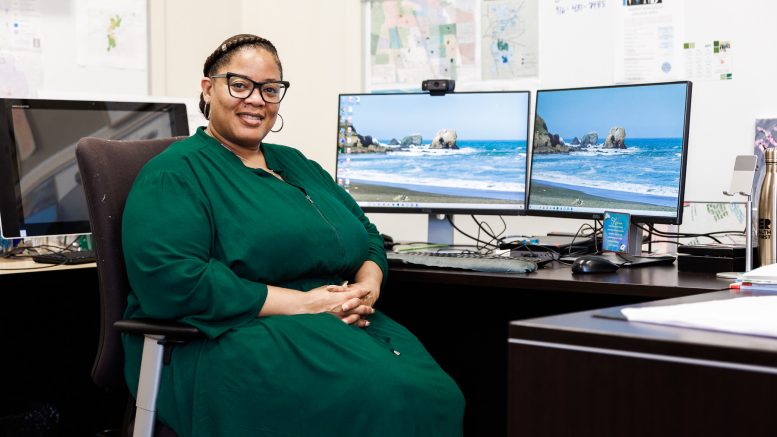By Kate Gonzales
When Christina Torres worked as a customer service representative for Covered California, she helped people navigate the health care system from her home during the pandemic. Some called about open enrollment; others about complications with their health coverage. She heard about cancer treatments and misdiagnoses. Some callers, exasperated with the state’s high cost of living, said they were ready to move.
“I’m like, ‘Where are you going? Take me with you,’” Torres joked during a recent interview.
She empathized with these callers because her family shared their struggles — and after two and a half years of living in motels and shelters, she’d begun to reestablish herself and her family in an apartment. But she and her husband, who works in construction, continue to feel strapped. Recently, they were served with an eviction notice for late rent.
“We’re never going to be able to save up,” Torres said. “We would kind of put funds aside and then tap in it because we had to. We can never save, just never.”
A lifelong Sacramentan, Torres (whose background is Chamorro) and her husband are among the thousands in Sacramento — and millions statewide — scraping by to afford their home. In California, 52% of renters spend at least 30% of their income on housing, making them rent burdened.
In August 2022, a report on Gender & Housing in California by the Gender Equity Policy Institute detailed how women, particularly those who are Black, Latina, Indigenous, elderly or are single mothers, are disproportionately affected by the state’s housing unaffordability. With the recognition that affordable housing is out of reach for too many Sacramentans, community coalitions and nonprofits are developing ways to keep people in their homes. For many like Torres, the need for solutions to the affordable housing crisis is urgent.
Early this year, Sacramento Area Congregations Together surveyed hundreds of local families for insight into household economics in Sacramento County. The responses about affordability weren’t necessarily surprising. Gabby Trejo said leaders have been sounding the alarm on working class families becoming priced out of their neighborhoods, as their income didn’t keep pace with Sacramento’s housing and living costs.
That was a decade ago, when Trejo first joined SacACT as the housing and homeless organizer. Today, the executive director of the multifaith community organization said they’ve seen that play out.
“We started this work because we were concerned around our unhoused population,” Trejo said. “But it became very evident that working families are experiencing this much more.”
Who suffers most from high housing costs
More than 10 million adults in California live in households that spend more than 30% of their income on housing, the definition of “rent” or “cost burdened.” Those who spend 50% or more are considered “severely rent burdened.”
For women, and particularly women of color, this problem is more acute. In California, 49% of women are rent burdened compared with 43% of men, according to the Gender Equity Policy Institute report. Among Black women renters, 59% are rent burdened; a third are severely rent burdened, compared with a quarter of women overall. A 2021 Zillow analysis found that the Black renters in the Sacramento region face the second-highest rent burden in the United States, after San Diego.
The GEPI report cites three main sources of the inequities in housing affordability: gender bias and discrimination; the higher likelihood of women leading a single-income household than men; and women’s earnings and accumulated wealth being lower than men’s.
“The economy just isn’t gender neutral,” said Darcy Totten, director of external affairs for the California Commission on the Status of Women and Girls. “And it doesn’t really work for all women.”
Totten was lead author of the state agency’s “Blueprint for Women’s Pandemic Economic Recovery,” which was released in November 2022 and details the existing gender inequities that were exacerbated during the pandemic, like women absorbing more child care responsibilities. The blueprint offers policy recommendations that include addressing the gendered and racial wage gaps and continuing investment in the social safety net programs that sustained people through the pandemic.
Adapting in response to community need
The GEPI report suggests approaching housing policy through a gender lens and urges the state to “collect and make publicly accessible more data disaggregated by gender and race.” On the ground in Sacramento, nonprofits and grassroots coalitions do the day-to-day work of helping people stay in their homes.
As director of the Building Healthy Communities hub in South Sacramento, Kim Williams and her teams saw the sharp rise in need around housing and advocacy beginning in 2020.
“Pretty much every single call we started to get was folks who were [saying], ‘I lost my job. … I can’t pay my rent, my landlord wants to evict me,’” said Williams, who has directed the BHC site since its founding in 2010. “That changed the game for us as far as our role in what housing was looking like.”
Williams said her nonprofit, part of a statewide public health initiative, reached out to partners like the Sacramento Housing Alliance and Legal Services of Northern California so they could better answer clients’ questions on things such as the temporary rent moratorium. That resulted in a Know Your Rights informational series in collaboration with Legal Services of Northern California that ran last year.
Williams also serves on the board of Sacramento Investment Without Displacement, a coalition that initiated a community benefits agreement for the UC Davis Aggie Square project — a planned roughly 25-acre development on UC Davis Medical Center property in Sacramento.
The collective effort sprang from the Building Healthy Communities’ Community Development Action Team, which was researching Aggie Square. To persuade the city and the public university at the bargaining table, the partners formalized the effort with the creation of Sacramento Investment Without Displacement and filed a lawsuit, which was later dropped.
In 2021, the city signed a community benefits agreement that committed to investing in affordable housing, among other things, in Oak Park and Tahoe Park, the neighborhoods surrounding the development.
“We want growth and innovation,” Williams said. “But it shouldn’t have to come at the price of our most vulnerable all the time. Like, isn’t everybody able to benefit a little bit?”
According to CapRadio, between 2010 and 2020, the Black population in Oak Park, a historically Black neighborhood, decreased by 24%. “You also don’t want people who have lived in the community for generations to now have to leave because they can’t afford to live there anymore,” Williams added.
Sacramento Area Congregations Together is one of the coalition’s 10 member organizations, with Trejo serving as SIWD board president. “At the core of what we believe, is that if the city is going to put in public funds, then there should be public benefit,” said Trejo.
The coalition is currently in negotiations on the details of the ordinance, including the city investment amount that would prompt a community benefits agreement for a specific project. The aim of SIWD is to set citywide standards so the agreements don’t have to be renegotiated for each development.
“If you got a large development going up in your neighborhood, if you want a seat at the table, you should be able to have a seat at the table,” Williams said. “Or you should at least know there’s residents at that table arguing on your behalf.”
The toll of unstable housing
Torres dreams of getting a good job, so she can help her family save money and eventually buy a house. With cash support from a faith program, they were able to stay in their current home after getting the eviction notice.
If she could, she’d return to school to earn her associate’s degree in administration — a goal derailed by the pandemic.
But right now, she said, “I feel like I’m such a burden.”
In her role with Building Healthy Communities, Williams sees the health consequences for parents struggling to stay afloat. She knows one mother who had daily headaches; another whose health problems worsened, leading to more frequent hospital visits.
“It is extremely stressful,” Williams said. “I think that’s any parent’s biggest fear, is not having a place for their child to lay their head at night.”
This story is part of the Solving Sacramento journalism collaborative. Solving Sacramento is supported by funding from the James Irvine Foundation and Solutions Journalism Network. Our partners include California Groundbreakers, Capital Public Radio, Outword, Russian America Media, Sacramento Business Journal, Sacramento News & Review, Sacramento Observer and Univision 19.




Be the first to comment on "Women of color are feeling the unbalanced burden of Sacramento’s rent crisis"